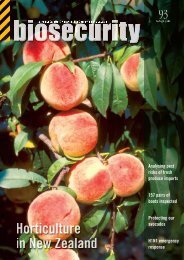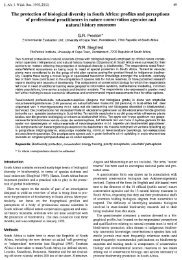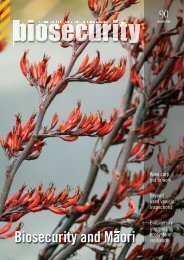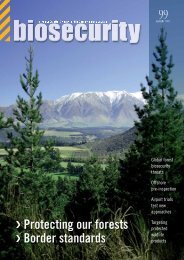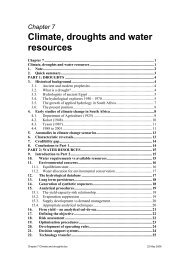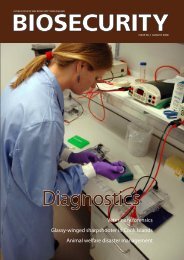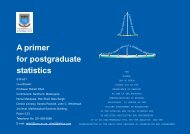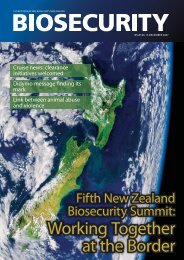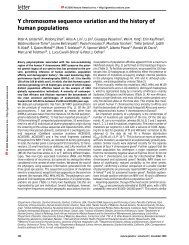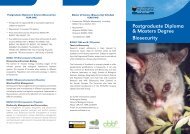Biosecurity magazine - Biosecurity New Zealand
Biosecurity magazine - Biosecurity New Zealand
Biosecurity magazine - Biosecurity New Zealand
Create successful ePaper yourself
Turn your PDF publications into a flip-book with our unique Google optimized e-Paper software.
Marine Value Mapping: questions of<br />
what, why and where<br />
MAF <strong>Biosecurity</strong> <strong>New</strong> <strong>Zealand</strong> (MAFBNZ’s) obligation to safeguard<br />
<strong>New</strong> <strong>Zealand</strong>’s marine environment from pests and diseases is a challenging task.<br />
MARINE<br />
92<br />
Marine borders are hard to<br />
manage because there is no<br />
single physical point of<br />
arrival – for example, organisms living<br />
on a vessel’s hull (biofouling – see pages<br />
4 and 8) have the potential to disperse<br />
into <strong>New</strong> <strong>Zealand</strong>’s coastal waters as a<br />
ship makes its way into port.<br />
To make matters even more difficult,<br />
water acts as a visual and physical<br />
barrier – surveillance activities are no<br />
simple task, and neither are efforts to<br />
collect general information on<br />
underwater ecosystems.<br />
Given the challenges and limitations of<br />
working in an underwater environment,<br />
it is not surprising that significant<br />
components of marine biodiversity are<br />
undescribed or yet to be discovered.<br />
To effectively manage biosecurity risks<br />
to <strong>New</strong> <strong>Zealand</strong>’s marine environment,<br />
it is critical that we have an<br />
understanding of what is at risk.<br />
Fundamental questions are “What do<br />
we want to protect?, Why do we want to<br />
protect it? and Where is it?”<br />
Knowing the identity, importance and<br />
location of “core values” allows<br />
government agencies to better anticipate<br />
potential impacts to the environment,<br />
and this knowledge can be used to<br />
prioritise management and inform<br />
decision making.<br />
To address this information need,<br />
MAFBNZ, in conjunction with the<br />
Department of Conservation (DoC),<br />
co-ordinated a research programme to<br />
identify and map a range of subcomponents<br />
for each of the following<br />
marine core values:<br />
• environmental – for example,<br />
habitat types, protected areas and<br />
species distributions;<br />
• economic – for example, coastal<br />
land value and commercial fishing;<br />
• social – for example, recreation<br />
sites and amenity value; and<br />
• cultural – for example fishing<br />
grounds such as taiāpure and<br />
mātaitai.<br />
Examples of some of the environmental value mapping datasets.<br />
A series of expert focus groups and hui<br />
were used to identify a range of<br />
sub-components for each of the four<br />
marine core areas as indicated above.<br />
The focus groups comprised a broad<br />
range of participants, each with specific<br />
expertise in the marine sciences,<br />
valuation theory and marine resource<br />
management. They included leading<br />
<strong>New</strong> <strong>Zealand</strong> scientists, economists,<br />
sociologists and representatives from<br />
several coastal iwi.<br />
For each of the selected subcomponents,<br />
the focus groups identified<br />
the methods and information available<br />
for assessing their characteristics<br />
(“value”) and locations. Relevant data<br />
holdings were then acquired, with a<br />
focus on sources that were freely<br />
available through sharing agreements,<br />
or within the public domain.<br />
In the final phase of the projects, the<br />
data was collated and then synthesised<br />
in a Geographic Information System<br />
(GIS) to produce maps of the core value<br />
sub-components.<br />
Although information on the<br />
distribution of coastal resources has<br />
already been assembled in geographic<br />
databases, in many cases it is<br />
fragmented among a range of national<br />
and regional authorities. This project is<br />
aimed towards consolidating spatial<br />
information on coastal values into a<br />
single, national source. The<br />
environmental and economic<br />
workstreams have been completed<br />
(reports are available at<br />
www.biosecurity.govt.nz/about-us/<br />
our-publications/technical-papers), and<br />
the social and cultural projects were<br />
scheduled to be completed in June 2009.<br />
The project is the first systematic<br />
attempt to identify and map<br />
components of value (environmental,<br />
economic, social and cultural) in<br />
relation to <strong>New</strong> <strong>Zealand</strong>’s coastal<br />
marine ecosystem. The comprehensive<br />
database of marine resources and their<br />
relative values can be applied to a<br />
variety of coastal zone impacts. In this<br />
way, the project will have wide benefits<br />
to coastal resource managers, including<br />
central and local government, scientists,<br />
researchers and environmental decision<br />
makers.<br />
It is also expected that the project will<br />
have additional conservation and<br />
management benefits outside the<br />
biosecurity perspective.<br />
■<br />
Dr Dan Kluza, Senior Adviser, Risk Analysis (Marine),<br />
MAFBNZ, daniel.kluza@maf.govt.nz<br />
MAF BIOSECURITY NEW ZEALAND 13




